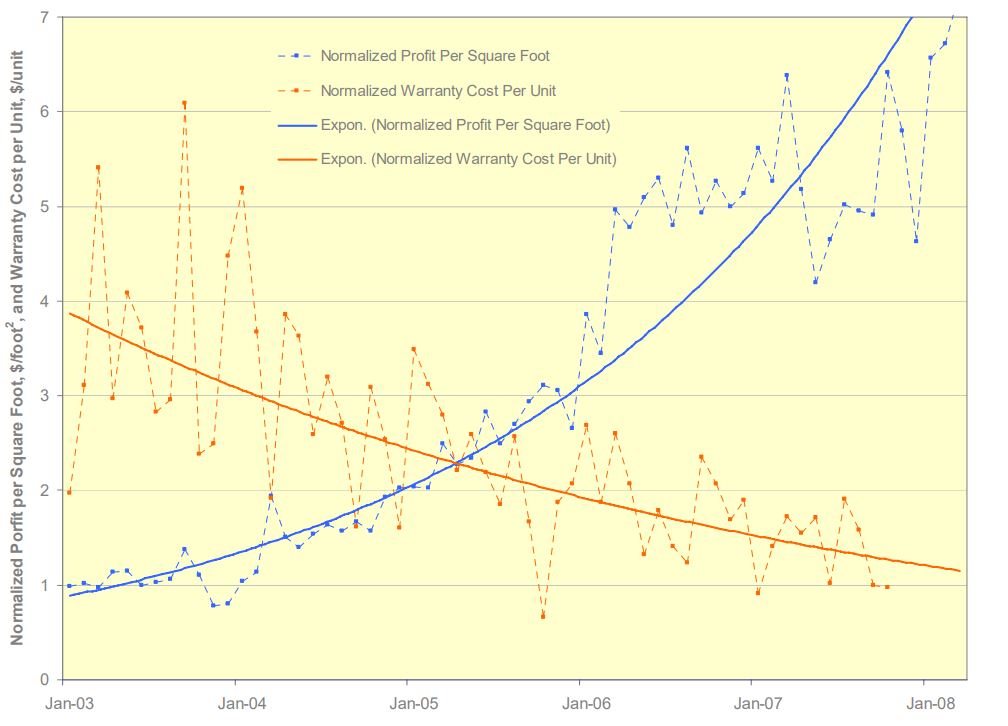When The Same Old Tricks Don’t Work
 Here’s what it looks like when the same old tricks no longer carry the day.
Here’s what it looks like when the same old tricks no longer carry the day.
Efficiency of effort
- For the same energy, you get more in return.
- For the same energy, you get the same in return.
- For more energy, you get the same in return.
- For more energy, you get less in return.
- Out of energy.
Efficiency of profit
- Increased profit and increased sales.
- Lesser increased profit and unchanged sales.
- Unchanged profit and unchanged sales.
- Decreased profit and unchanged sales.
- Decreased profit and decreased sales.
- No profit and no sales.
Vibrancy
- High-energy citizens with a strong customer focus.
- Medium energy team members with some customer focus.
- Medium-energy people with little customer focus.
- Lethargic nameless humans with no customer focus.
- Nobody home.
Time Horizon
- Long-term purpose, medium-term execution, short-term adaptation.
- Medium-term execution, short-term adaptation.
- Short-term execution, shorter-term bickering.
- Shortest-term floundering.
- Out of time.
Truthfulness
- Truthful communication is delivered clearly and skillfully.
- Truthful communication is delivered less skillfully.
- Partial truths delivered.
- Partial truths delivered unskillfully.
- No truths.
Trust
- Many tight groups of informal networks share information naturally and effectively.
- Informal networks share information naturally.
- Informal networks share information.
- Informal networks go underground to share information.
- Informal networks go underground and band together to protect each other.
- Informal networks give up.
Image credit — philhearing
How To Put Yourself Out There
 When in doubt, put it out there. Easy to say, difficult to do.
When in doubt, put it out there. Easy to say, difficult to do.
Why not give it a go? What’s in the way? A better question: Who is in the way? I bet that who is you.
I’ve heard the fear of failure blocks people from running full tilt into new territory. Maybe. But I think the fear of success is the likely culprit.
If you go like hell and it doesn’t work, the consequences of failure are clear, immediate, and short-lived. It’s like skinning your knee. Everyone knows you went down hard and it hurts in the moment. And two days after the Band-Aid, you’re better.
If you run into the fire and succeed, the consequences are unknown, and there’s no telling when those consequences will find you. Will you be seen as an imposter? Will soar to new heights only to fail catastrophically and publicly? Will the hammer drop after this success or the next one? There’s uncertainty at every turn and our internal systems don’t like that.
Whether it’s the fear of success or failure, I think the root cause is the same: our aversion to being judged by others. We tell ourselves stories about what people will think about us if we fail and if we succeed. In both cases, our internal stories scratch at our self-image and make our souls bleed. And all this before any failure or success.
I think it’s impossible to stop altogether our inner stories. But, I think it is possible to change our response to our inner stories. You can’t stop someone from calling you a dog. But when they call a dog, you can turn around and look to see if you have a tail. And if you don’t have a tail, you can tell yourself objectively you’re not a dog. And I think that’s a good way to dismiss our internal stories.
The next time you have an opportunity put yourself out there, listen to the stories you tell yourself. Acknowledge they’re real and acknowledge they’re not true. They may call you a dog, but you have no tail. So, no, you’re not a dog.
You may fail or you may fail. But the only way to find out is to put yourself out there. Whether you fail or succeed, you don’t have a tail and you’re not a dog. So you might as well put yourself out there.
Image credit — Tambako the Jaguar
There’s no such thing as 100% disagreement.
 Even when there is significant disagreement, there is not 100% disagreement.
Even when there is significant disagreement, there is not 100% disagreement.
Can both sides agree breathing is good for our health? I think so. And if so, there is less than 100% disagreement. Now that we know agreement is possible, might we stand together on this small agreement platform and build on it?
Can both sides agree all people are important? Maybe not. But what if we break it down into smaller chunks? Can we agree family is important? Maybe. Can we agree my family is important to me and your family is important to you? I think so. Now that we have some agreement, won’t other discussions be easier?
Can we agree we want the best for our families? I think so. And even though we don’t agree on what’s best for our families, we still agree we want the best for them. What if we focused on our agreement at the expense of our disagreement? Down the road, might this make it easier to talk to each other about what we want for our families? Wouldn’t we see each other differently?
But might we agree on some things we want for our families? Do both sides agree we want our families to be healthy? Do we agree we want them to be happy? Do we agree we want them to be well-fed? Do we want them to be warm and dry when the weather isn’t? With all this agreement, might we be on the same side, at least in this space?
But what about our country? Is there 100% disagreement here? I think not. Do we agree we want to be safe? Do we agree we want the people we care about to be safe? Do we agree we want good roads? Good bridges? Do we agree we want to earn a good living and provide for our families? It seems to me we agree on some important things about our country. And I think if we acknowledge our agreement, we can build on it.
I think there’s no such thing as 100% disagreement. I think you and I agree on far more things than we realize. When we meet, I will look for small nuggets of agreement. And when I find one, I will acknowledge our agreement. And I hope you will feel understood. And I hope that helps us grow our agreement into a friendship built on mutual respect. And I hope we can teach our friends to seek agreement and build on it.
I think this could be helpful for all of us. Do you agree?
Image credit — Orin Zebest
It’s not the work, it’s the people.
 I used to think the work was most important. Now I think it’s the people you work with.
I used to think the work was most important. Now I think it’s the people you work with.
Hard work is hard, but not when you share it with people you care about.
Struggle is tolerable when you’re elbow-to-elbow with people you trust.
Fear is manageable when you have faith in your crew.
You’re happy to carry an extra load when your friend needs the help.
And your friend is happy to do the same for you.
When you’ve been through the wringer a teammate, they grow into more than a teammate.
If you smile at work, it’s likely because of the people you work with.
And when you’re sad at work, it’s also likely because of to the people.
When you care about each other, things get easier, even when they’re not easy.
Stop what you’re doing and look at the people around you.
What do you see?
Who has helped you? Who has asked for help?
Who has confided in you? To whom have you confided?
Who believes in you? In whom do you believe?
Who are you happy to see? Who are you not?
Who will you miss when they’re gone?
For the most important people, take a minute and write down your shared experiences and what they mean to you.
What would it mean to them if you shared your thoughts and feelings?
Why not take a minute and find out?
Wouldn’t work be more energizing and fun?
If you agree, why not do it? What’s in the way? What’s stopping you?
Why not push through the discomfort and take things to the next level?
Image credit — HLI-Photography
When I’m Asked To Take On New Work
 Here are the questions I ask myself when I’m asked to take on new work….
Here are the questions I ask myself when I’m asked to take on new work….
Do I know what the work is all about?
Is it well-defined?
Would it make a big difference if the work is completed successfully?
Would it make a big difference if it’s not?
Is it clear how to judge if the work is completed successfully?
Is the work important and how do I know?
Is it urgent? (The previous question is far more important to me.)
Is there more important work?
Who would benefit from the work and how do I feel about it?
Would I benefit and how do I feel about it?
Am I uniquely qualified or can others do the work?
Am I interested in the work?
Would I grow from the work?
Who would I work for?
Who would I work with?
Would my career progress?
Would I get a raise?
Would I spend more time with my family?
Would I spend more time in meetings?
Would I travel more?
What does my Trust Network think?
Would I have fun? (I think this is a powerful question.)
These aren’t the questions you should ask yourself, but I hope the list helps you develop your own.
Image credit — broombesoom
Swimming In New Soup
 You know the space is new when you don’t have the right words to describe the phenomenon.
You know the space is new when you don’t have the right words to describe the phenomenon.
When there are two opposite sequences of events and you think both are right, you know the space is new.
You know you’re thinking about new things when the harder you try to figure it out the less you know.
You know the space is outside your experience but within your knowledge when you know what to do but you don’t know why.
When you can see the concept in your head but can’t drag it to the whiteboard, you’re swimming in new soup.
When you come back from a walk with a solution to a problem you haven’t yet met, you’re circling new space.
And it’s the same when know what should be but it isn’t – circling new space.
When your old tricks are irrelevant, you’re digging in a new sandbox.
When you come up with a new trick but the audience doesn’t care – new space.
When you know how an experiment will turn out and it turns out you ran an irrational experiment – new space.
When everyone disagrees, the disagreement is a surrogate for the new space.
It’s vital to recognize when you’re swimming in a new space. There is design freedom, new solutions to new problems, growth potential, learning, and excitement. There’s acknowledgment that the old ways won’t cut it. There’s permission to try.
And it’s vital to recognize when you’re squatting in an old space because there’s an acknowledgment that the old ways haven’t cut it. And there’s permission to wander toward a new space.
Image credit — Tambaco The Jaguar
If you want to make a difference, change the design.
 Why do factories have 50-ton cranes? Because the parts are heavy and the fully assembled product is heavier. Why is the Boeing assembly facility so large? Because 747s are large. Why does a refrigerator plant have a huge room to accumulate a massive number of refrigerators that fail final test? Because refrigerators are big, because volumes are large, and a high fraction fail final test. Why do factories look as they do? Because the design demands it.
Why do factories have 50-ton cranes? Because the parts are heavy and the fully assembled product is heavier. Why is the Boeing assembly facility so large? Because 747s are large. Why does a refrigerator plant have a huge room to accumulate a massive number of refrigerators that fail final test? Because refrigerators are big, because volumes are large, and a high fraction fail final test. Why do factories look as they do? Because the design demands it.
Why are parts machined? Because the materials, geometries, tolerances, volumes, and cost requirements demand it. Why are parts injection molded? Because the materials, geometries, tolerances, volumes, and cost requirements demand it. Why are parts 3D printed? For prototypes, because the design can tolerate the class of materials that can be printed and can withstand the stresses and temperature of the application for a short time, the geometries are printable, and the parts are needed quickly. For production parts, it’s because the functionality cannot be achieved with a lower-cost process, the geometries cannot be machined or molded, and the customer is willing to pay for the high cost of 3D printing. Why are parts made as they are? Because the design demands it.
Why are parts joined with fasteners? It’s because the engineering drawings define the holes in the parts where the fasteners will reside and the fasteners are called out on the Bills Of Material (BOM). The parts cannot be welded or glued because they’re designed to use fasteners. And the parts cannot be consolidated because they’re designed as separate parts. Why are parts held together with fasteners? Because the design demands it.
If you want to reduce the cost of the factory, change the design so it does not demand the use of 50-ton cranes. If you want to get by with a smaller factory, change the design so it can be built in a smaller factory. If you want to eliminate the need for a large space to store refrigerators that fail final test, change the design so they pass. Yes, these changes are significant. But so are the savings. Yes, a smaller airplane carries fewer people, but it can also better serve a different set of customer needs. And, yes, to radically reduce the weight of a product will require new materials and a new design approach. If you want to reduce the cost of your factory, change the design.
If you want to reduce the cost of the machined parts, change the geometry to reduce cycle time and change to a lower-cost material. Or, change the design to enable near-net forging with some finish machining. If you want to reduce the cost of the injection molded parts, change the geometry to reduce cycle time and change the design to use a lower-cost material. If you want to reduce the cost of the 3D printed parts, change the design to reduce the material content and change the design and use lower-cost material. (But I think it’s better to improve function to support a higher price.) If you want to reduce the cost of your parts, change the design to make possible the use of lower-cost processes and materials.
If you want to reduce the material cost of your product, change the design to eliminate parts with Design for Assembly (DFA). What is the cost of a part that is designed out of the product? Zero. Is it possible to wrongly assemble a part that was designed out? No. Can a part that’s designed out be lost or arrive late? No and no. What’s the inventory cost of a part that’s been designed out? Zero. If you design out the parts is your supply chain more complicated? No, it’s simpler. And for those parts that remain use Design for Manufacturing (DFM) to work with your suppliers to reduce the cost of making the parts and preserve your suppliers’ profit margins.
If you want to sell more, change the design so it works better and solves more problems for your customers. And if you want to make more money, change the design so it costs less to make.
Resurrecting Manufacturing Through Product Simplification
Product simplification can radically improve profits and radically improve product robustness. Here’s a graph of profit per square foot ($/ft^2) which improved by a factor of seven and warranty cost per unit ($/unit), a measure of product robustness), which improved by a factor of four. The improvements are measured against the baseline data of the legacy product which was replaced by the simplified product. Design for Assembly (DFA) was used to simplify the product and Robust Design methods were used to reduce warranty cost per unit.

I will go on record that everyone will notice when profit per square foot increases by a factor of seven.
And I will also go on record that no one will believe you when you predict product simplification will radically improve profit per square foot.
And I will go on record that when warranty cost per unit is radically reduced, customers will notice. Simply put, the product doesn’t break and your customers love it.
But here’s the rub. The graph shows data over five years, which is a long time. And if the product development takes two years, that makes seven long years. And in today’s world, seven years is at least four too many. But take another look at the graph. Profit per square foot doubled in the first two years after launch. Two years isn’t too long to double profit per square foot. I don’t know of a faster way, More strongly, I don’t know of another way to get it done, regardless of the timeline.
I think your company would love to double the profit per square foot of its assembly area. And I’ve shown you the data that proves it’s possible. So, what’s in the way of giving it a try?
For the details about the work, here’s a link – Systematic DFMA Deployment, It Could Resurrect US Manufacturing.
Effectiveness Before Efficiency
 Efficient – How do we do more projects with fewer people?
Efficient – How do we do more projects with fewer people?
Effective – Let’s choose the right project.
Would you rather do more projects that miss the mark or fewer that excite the customer?
Efficient – How do we finish the project faster?
Effective – Let’s fully staff the project.
Would you rather burn out the project team or deliver on what the customer wants?
Efficient – How do we reduce product cost by 5%?
Effective – Let’s make customers’ lives easier.
Would you rather reduce the cost or delight the customer?
Efficient – How can we go faster?
Effective – Let’s get it right.
Would you rather go fast and break things or get it right for the customer?
Efficient – How many projects can we run in parallel?
Effective – Let’s fully staff the most important projects.
Would you rather get halfway through four projects or complete two?
Efficient – How do we make progress on as many tasks as possible?
Effective – Let’s work on the critical path.
Would you rather work on things that don’t matter or nail the things that do?
Efficient – How can we complete the most tasks?
Effective – Let’s work on the hardest thing first.
Would you rather learn the whole thing won’t work before or after you waste time on the irrelevant?
If there’s a choice between efficiency and effectiveness, I choose effectiveness.
Image credit — Antarctica Bound
When in doubt, start.
 At the start, it’s impossible to know the right thing to do, other than the right thing is to start.
At the start, it’s impossible to know the right thing to do, other than the right thing is to start.
If you think you should have started, but have not, the only thing in the way is you.
If you want to start, get out of your own way, and start.
And even if you’re not in the way, there’s no harm in declaring you ARE in the way and starting.
If you’re afraid, be afraid. And start.
If you’re not afraid, don’t be afraid. And start.
If you can’t choose among the options, all options are equally good. Choose one, and start.
If you’re worried the first thing won’t work, stop worrying, start starting, and find out.
Before starting, you don’t have to know the second thing to do. You only have to choose the first thing to do.
The first thing you do will not be perfect, but that’s the only path to the second thing that’s a little less not perfect.
The second thing is defined by the outcome of the first. Start the first to inform the second.
If you don’t have the bandwidth to start a good project, stop a bad one. Then, start.
If you stop more you can start more.
Starting small is a great way to start. And if you can’t do that, start smaller.
If you don’t start, you can never finish. That’s why starting is so important.
In the end, starting starts with starting. This is The Way.
Image credit — Claudio Marinangeli
How To Elevate The Work
 If you want people to work together, give them a reason. Tell them why it’s important to the company and their careers.
If you want people to work together, give them a reason. Tell them why it’s important to the company and their careers.
If you want people to change things, change how they interact. Eliminate leaders from some, or all, of the meetings. Demand they set the approach. Give them control over their destiny. Make them accountable to themselves. Give them what they ask for.
If you want to create a community, let something bad happen. The right people will step up and the experts will band together around the common cause. And after they put the train back on the track, they’ll be ready and willing for a larger challenge.
If you want the team to make progress, make it easy for them to make progress. Stop the lesser projects so they can focus. Cancel meetings so they can focus. Give them clear guidance so they can focus on the right work. Give them the tools, time, training, and a teacher. Ask them how to make their work easier and listen.
If you want the team to finish projects faster, ask them to focus on effectiveness at the expense of efficiency.
If you want the organization to be more flexible, create the causes and conditions for trust-based relationships to develop. When people work shoulder-to-shoulder on a difficult project trust is created. And for the remainder of their careers, they will help each other. They will help each other despite the formal organizational structure. They will help each other despite their formal commitments. They will help each other despite the official priorities.
If you want things to change, don’t try to change people. Move things out of the way so they can make it happen.
Image credit — frank carman
 Mike Shipulski
Mike Shipulski